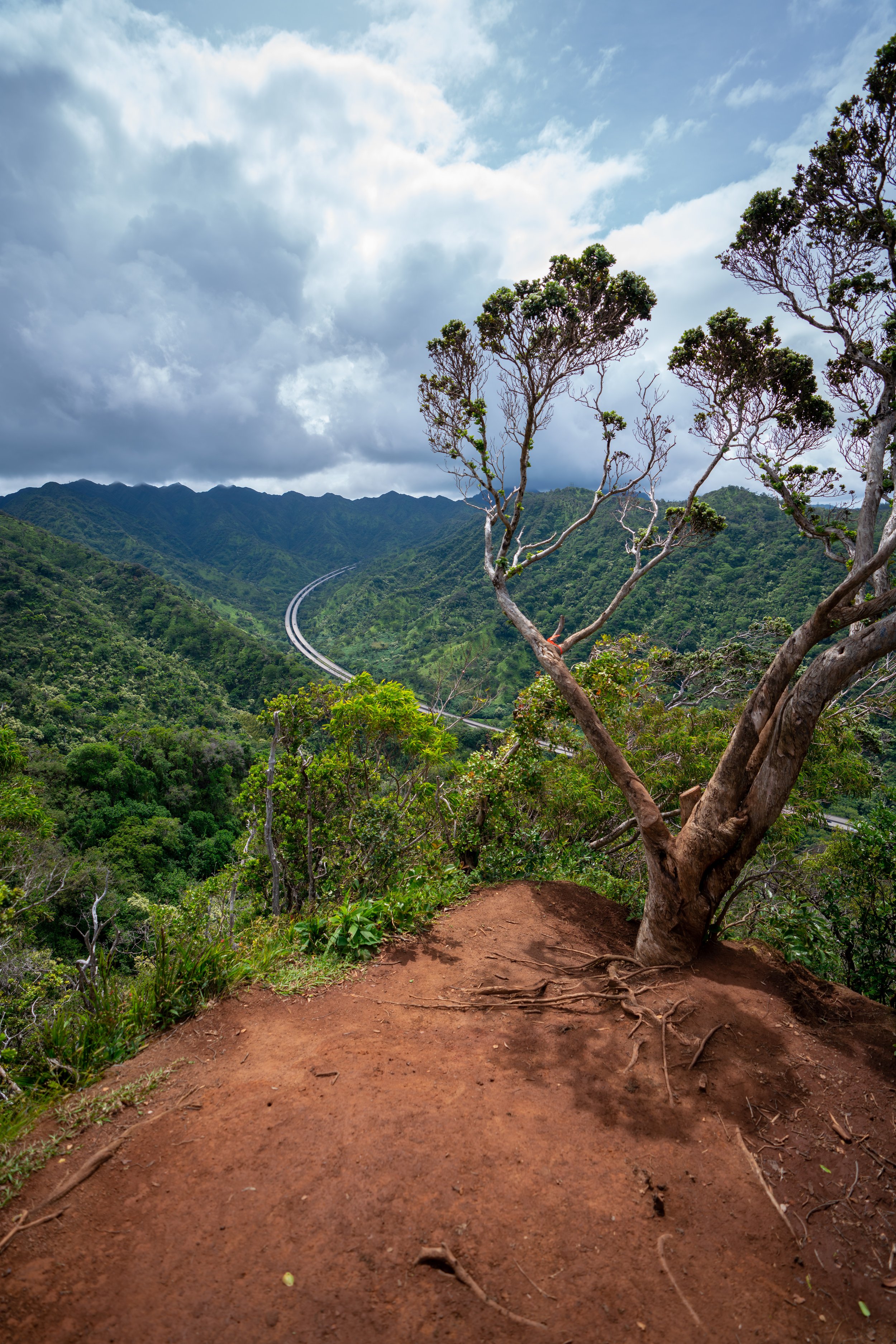Hiking the Koko Crater Stairs on Oʻahu, Hawaiʻi
Distance (Roundtrip): 0.9 mile / 1.4 km
Elevation Gain: ~930 ft. / 283 m
The Koko Head Stairs is a beautiful but steep east Oʻahu hike in Hawaiʻi Kai that climbs the slopes an ancient volcanic crater, following the steps of a historic WWII-era tramway that was built in the early 1940s by the U.S. Army.
Since then, the Koko Crater Stairs have become a favorite among both locals and visitors from around the world, with many Oʻahu residents hiking the railway as a quick morning or evening workout at either sunrise and sunset.
To that point, I personally only recommend hiking the Koko Crater Stairs early or late in the day, as the steep and challenging trail is nothing to take lightly during the heat of the day!
How Long Does it Take to Hike Koko Head?
For most people, hiking Koko Head should take somewhere between 30 minutes - 1 hour.
However, if you hike the stairs without taking any breaks, the whole trail should take under 25 minutes.
What is the Fastest Koko Head Time?
Going off of Strava, the fastest known Koko Head time is 8:32 set by Conrad Newfield who is also the same Koʻolau Summit Trail (KST) record holder!
This makes my time at 10:43 look pretty weak!
Koko Head Trailhead Parking
Parking for the Koko Crater Railway Trail is located in the back parking lot of Koko Head District Park in Hawaiʻi Kai.
That being said, it’s important to know that toward sunset on any given day, this parking lot can get busy and even fill completely if there are a lot of baseball games going on within the park.
Google Maps Directions: Koko Head Trailhead
Getting to the Trailhead
From the parking lot, walk around the baseball fields to reach an asphalt road that leads to a dirt path, which takes you to the base of the stairs.
At this split, go right up this path to find the stairs shortly ahead.
Hiking the Koko Crater Stairs
Thanks to the amazing volunteer work by the Kokonut Koalition, the Koko Crater Stairs are in better shape than ever, from their eroded and deteriorated state.
This means that hiking the Koko Head Stairs is now a much better and more enjoyable experience, thanks to all of the private donations and hard volunteer work that went into the trail’s restoration.
Kohelepelepe Trail (Koko Crater Stairs)
On a different note, what you see in the photo below is what you get, meaning there are truly no directions that you would need to know in order to hike the Koko Head Stairs.
That being said, the stairs start off relatively mild, but they only get steeper and more challening the closer you get to the summit.
Koko Crater Bridge (Murphy’s Bypass)
About halfway up the trail, the Koko Head Stairs reach the infamous Koko Crater Bridge.
If you are coordinated and comfortable with heights, crossing over the bridge can be done fairly quickly, so long as you don’t miss a step.
Alternatively, if you’d rather bypass the bridge altogether, there is a path around to the right side of the bridge, known locally as Murphy’s Bypass.
Warning
Bees have been known to be a problem on the Koko Crater bridge.
By this, I mean that hives are not uncommon in this area, and even with constant removal efforts from the city, they always seem to come back.
That being said, I have personally never had an issue with them because I try to move through this area as quickly as possible.
This final ascent is generally regarded as the most difficult part of the entire Koko Head hike, as it is the steepest section of all 1,048 steps to the top!
The top of the main set of steps is where the Oʻahu community widely agrees that recorded times stop, which goes hand in hand with the fastest known Koko Crater time on Strava.
This is because the final steps that continue to the true summit have not always been in place, and they are a very much restored and 'recent' addition to main railway up Koko Crater.
Through the volunteer efforts mentioned previously, the Kokonut Koalition has restored this final set of the stairs to the summit, which had been deteriorated and overtaken by the surrounding overgrowth.
Puʻu Mai (Koko Head Summit)
Unfortunately, the large metal grate seen in the cover photo above has been replaced with the viewing platform here, and I say ‘unfortunately’ because most locals were pretty upset when the city made this change, as there wasn’t any community input before the replacement took place.
Either way, this small platform is what we have now, but there are countless other areas to explore on the summit that can make for great photo opportunities!
On a different note, the summit of Puʻu Mai is really just one small section of the Koko Crater Rim Trail that begins and ends in the Koko Crater Botanical Garden below.
I mention this because I think it’s worth walking out to the edge of the descent on either the North or South Rim, with the north side having the best views to see the most challenging sections around the crater. Now, I don’t mention this to encourage hiking the Koko Crater Rim if you aren’t prepared for it, as the hike—while short in distance—is very steep, exposed, and traverses many tricky sections that are absolutely no-fall zones.
Take that as you will, but I’m certain that the Koko Crater Rim Trail is not meant for all people of all abilities.
Read My Separate Post: Koko Crater Rim Trail
What Islands Can You See from the Top of Koko Crater?
On a clear day, you can see Molokai, Lānaʻi, and sometimes Maui from the top of Koko Head.
That said, a few hikers in the comment section below have said that you can see the Big Island from the summit—but only on the clearest of all days!
However, I am skeptical, as I have yet to see it myself, and I have climbed the Koko Crater Stairs hundreds of times! To add to this, I have very clearly seen both Mauna Kea and Mauna Loa on Hawaiʻi Island from Oʻahu, but only from a very different and much higher vantage point on the clearest day imaginable!
Hiking Down
Since the stairs are so steep, I personally find the hike back down to be almost worse than the strenuous hike up.
That said, some hikers may prefer to carry trekking poles for the way down, but either way, take it slow, as injuries from falls are seemingly always worse going down than those on the hike up.
Native Plants on the Koko Crater Stairs
For such a short, low-elevation trail, it feels surprising by Hawaiʻi standards to find a few different native plants along the Koko Crater Stairs.
However, if you look off to the sides of the trail you may see ʻAʻaliʻi and ʻUhaloa growing on either side of the stairs, which are the two most notable natives that can be found.
If you would like to learn more about these and many other native Hawaiian plants from across the islands, I encourage you to check out my separate post linked below.
Read My Separate Post: Native Hawaiian Plant Guide












